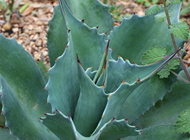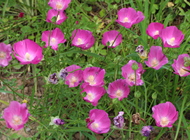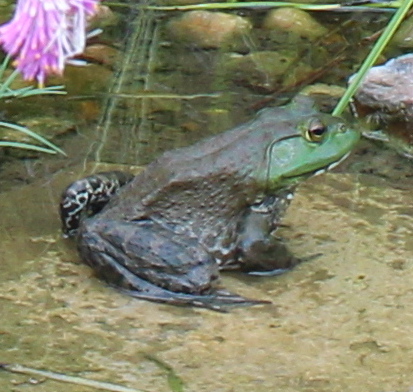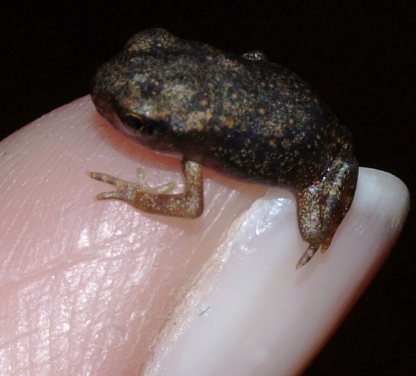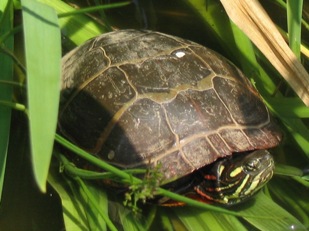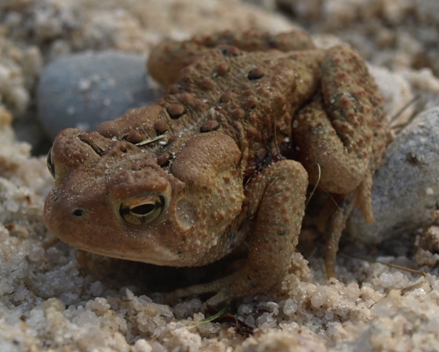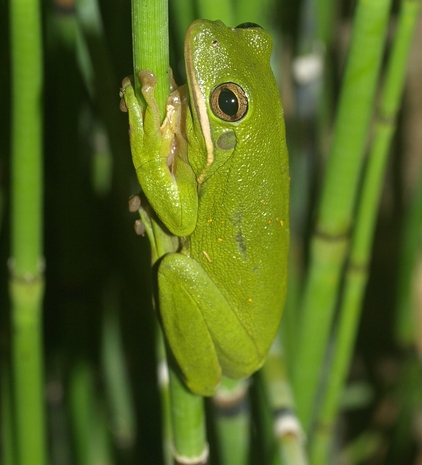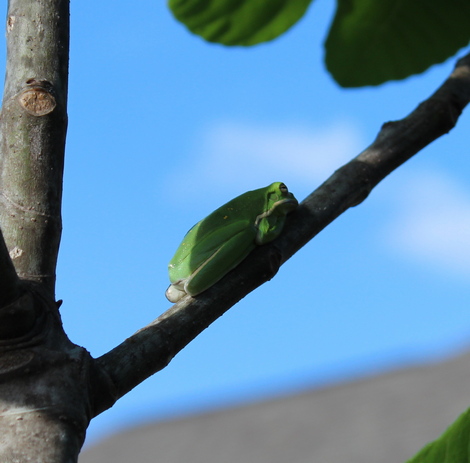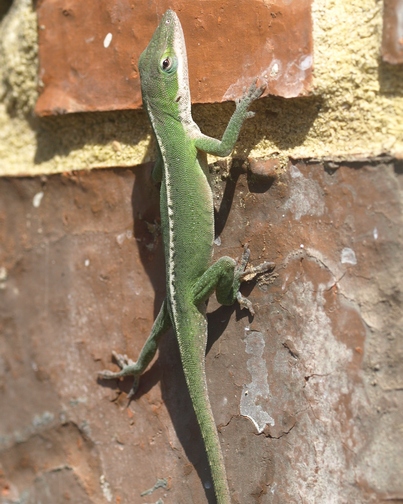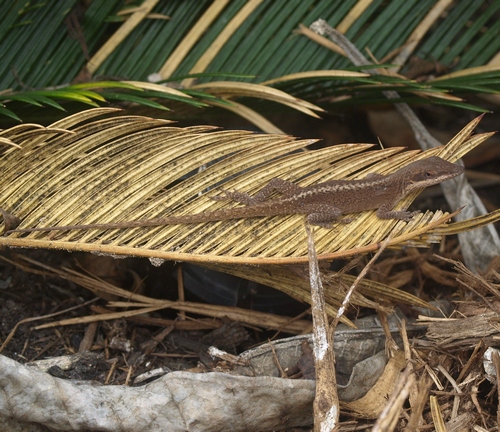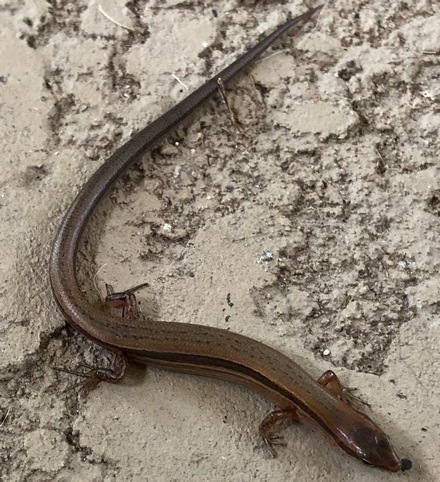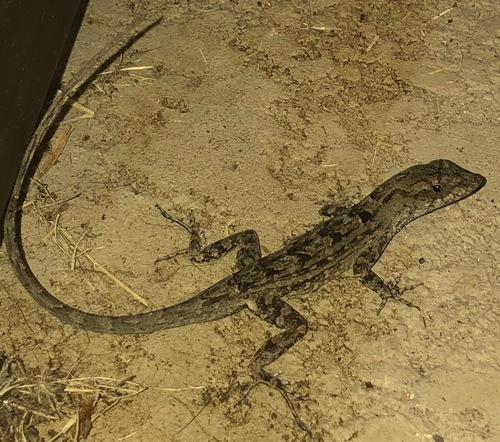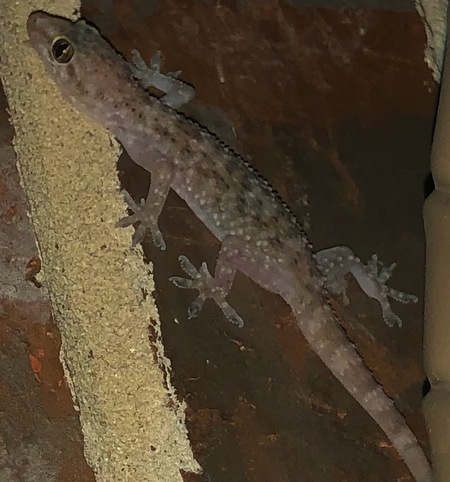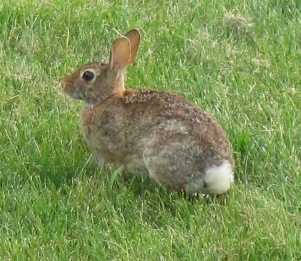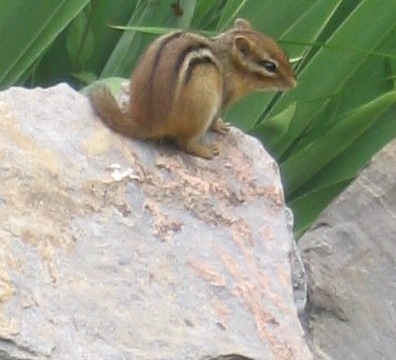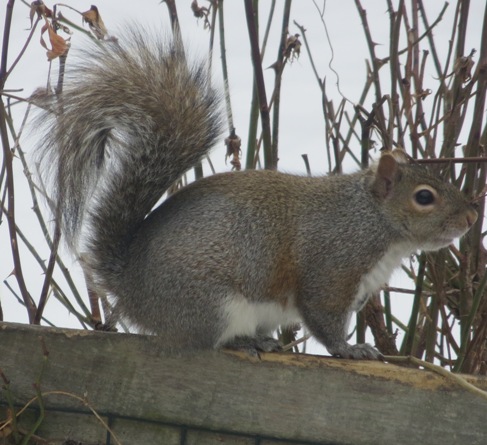Boney?What with the incredible diversity of boneless lifeforms (insects, spiders, worms, you name it), the bone-in offerings seem a bit more limited. Birds have their own page, so this page features the swimming, slithering and scampering denizens of our garden – that would be mammals, reptiles, amphibians, and fish. Pondsters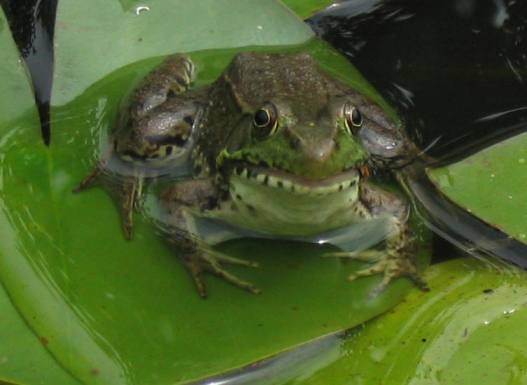
We hope to see frogs every year in our pond. When we put in our first
Pennsylania, we bought a few bullfrog tadpoles and watched them
grow. I think they survived the first winter, but one of the following winters,
they all gave up. After that, no further frog life until we installed the much
larger swimming pond, which did attract American bullfrogs like the one pictured
at right. Usually, there wouldn't be frogs in the pond in the spring
and early summer, but a few would show up by mid-summer
and hang around for the rest of the season. I always thought that with all the goldfish running
amock in our patio pond, frog eggs probably wouldn't stand a chance, but I have
since seen toad eggs (and toadpoles) successfully co-exist with goldfish and
koi in our Texas pond, so perhaps the same holds for frogs.
Speaking of the Texas pond – American bullfrogs (Rana catesbeiana) seem
to have a hard time living there. Several times in the first few years we had
the pond, a bullfrog would settle in, only to mysteriously die after a little
while. It may be that the water gets too warm in the dog days of summer (the
goldfish don't seem to mind that). In any case, the summer of 2020 finally
brought a more resilient representative of the species to our pond – a
female, I believe, who likes to hang out in the spillway that gently returns
water from our waterfall back to the main pond. She is quite skittish, and
usually all we notice is a big splash as we venture near the pond, sometimes
preceded by a loud squeak. She's huge, though, and can easily be spotted from
inside the house, which means a determined human can devise a sneaky approach to
the pond to get a closer look before her inevitable evasive maneuvers. We count
on her to eat lots of mosquitoes.
Wow, I couldn't believe how tiny this amphibianlet was
tht Ben found hopping across our patio. It must have hatched from the
adjacent little pond, but I don't know what it is — the only frogs
we've seen in our garden are American bullfrogs, and they have huge
tadpoles. No way could something as teeny as this (that's Amy's little pinky
nail, by the way) grow out of that, right? So I'm calling it a mini-toad for
now. If you can tell me with more certainty what this is, please let me know
(see the link at the bottom of this page).
A turtle is something new to our garden and pond. While driving through our
neighborhood one day this spring, Amy noticed this fella crossing the road,
and "rescued" it to our pond. Turns out it's an Eastern painted turtle
(Chrysemys picta picta), whose species is widely distributed
throughout the US. It was probably making its way from one of the natural
ponds in our area, in search of a better place to pass time - I hope it
doesn't mind its new digs. So far, it has been perfectly content, but until today
it was very shy - we couldn't get closer than about 20 ft away before it would
unceremoniously plump back into the (murky) pond. Recently, it has relaxed a
bit, allowing me to take this photo of our Boxy sitting amidst blue flag
leaves in the pond.
When we first moved into our house, I used to see toads every now
and then. In the years that followed, the entire area around us was built up
in neighborhoods, and toads didn't come around any more - much to my dismay.
So I've been very pleased with their return in recent years, gladly putting up
with their shrill mating calls in spring. So far I haven't tried to figure out
which kind(s) they are - some certainly seem more brown, others more on the
green side. I also don't know if they reproduce in our garden - our pond's
bog filter seems like it should be a good place for toadpoles, but we have yet
to see any.
For a little guy (much smaller than those bullfrogs above),
this American tree frog (Hyla cinerea) sure makes a lot of noise! So much,
in fact, that it led to the expulsion from our garden of the first one our
family encountered, on account of it keeping half the family up for most of its
first night in attendance. But we allowed a second one, which didn't have quite
as powerful a voicebox, to stay in the garden. Its suction cup fingers are
amazing, allowing it to climb vertically up any smooth surface (and even
latching on to the fingers of those who dare catch it). The little fella
pictured here had taken refuge in a stand of horsetail rush after Ben had
located it by its night-time call.
A couple years later, I spotted another tree frog (actually,
Amy did), this one quite a bit larger and perched high up in a fig tree. It
seemed a little grumpy, and scooched to the far side of the branch as I tried
to approach to snap its picture. But I bet he'll serenade us tonight all the
same!
ReptilesIn time, I hope to be able to show photos of a resident snake, but no
such luck just yet. So this section is limited to a few foot-equipped
reptilians for now:
Upon arrival in Texas, we were delighted to see lizards
everywhere. One local nursery has them climbing through all of their
plants. Even before our garden featured much of any climbable vegetation,
we'd see these green anoles (Anolis carolinensis) on our patio and
climbing our brick walls. They have become much more prolific in the years
since, now that there are lots of plants to scamper around in. We're always
happy to see them.
Green anoles aren't always green. Well before I spotted
my first brown anole (see below), I noticed many brown-hued representatives
of Anolis carolinensis. They may be color variants or perhaps just
wearing their early-winter brown coats. This one was content to sun itself on a
freeze-damaged frond of our sago palm for over an hour.
Five years after moving to our Texas home, finally another
verifiable reptile sighting: I found a little brown skink (Scincella lateralis)
scurrying snake-like across our patio. Its species stays small (typically less than
five inches long) and is easily identified by its lateral dark stripes. Another
interesting feature is the window in its eyelids, which allows it to see when its
eyes are closed. It likes to live in leaf litter, so is most common in forests
and woodlots (I'm happy that it chose to classify our garden as a woodlot, and
heartily agree). Its meals consist mostly of ground-dwelling insects of many kinds.
I hope it likes fire ants...
Finally, after living here in Houston for nearly six
years, a genuine brown anole (Anolis sagrei) showed itself. Unlike
their green cousins, who are native to the US, this is an introduced
species, occurring natively in the Caribbean. It shows more elaborate
patterning on its back, and is typically a ground dweller, leaving trees and
plants to the green guys. They have a similar diet though, consuming lots
of spiders and insects.
Another few months later, another new lizard sighting.
I'd on occasion noticed things that didn't look like anoles scurrying
quickly out of the way as I approached, mainly near my compost bins, but
never caught a good look. They always seemed like geckos to me though, and
this new sighting confirms that they indeed live around our home. Amy and I
spotted two little ones (youngsters, I presume) on our garage door when
returning from a dinner out, and although they tried to scoot as I got
closer, I managed to snap a shot of this one as he hid behind a downspout.
It's a Mediterranean house gecko (Hemidactylus turcicus), which has
spread far and wide from its native range and is not the least bit
endangered. It's also known as the moon lizard for its nocturnal habit,
which explains why I have tended to encounter it at dusk and beyond. They
grow to six inches – a little bigger than the one pictured here
– and eat insects like their anole cousins.
Furry onesBesides the occasional rat enjoying the smorgasbord that is our compost bin (and of course our resident cats and dogs), we haven't seen mammals in our Texas garden. That's probably a good thing – the wild hogs that live around here are amazingly destructive, and from what I've heard, armadillos aren't much better. Coyotes seem a tad on the scary side. Squirrels do live around here, and probably will find their way here eventually, but they haven't been attracted to our new development with mostly small trees just yet. Same goes for the possums and coons, which show up as roadkill on nearby roads, but not thus far in the garden. Skunks make their presence known in the neighborhood on occasion, but I haven't spotted them in person. So the descriptions below all pertain to our old garden in Pennsylvania... Mammal life is limited in our garden. We always have rabbits, and Mr.
Squirrel shows up to empty our birdfeeders in winter (but is nowhere to be
seen the rest of the year). We see our chipmonks some years, but not very
often, and groundhogs haven't made an appearance recently. Most voles we
see show up on our patio lifeless, victims of our predator kittycat. Deer,
who live on the other end of our neighborhood, have only ventured into our
garden on two occasions, and have not made it their larder thus far (knock
on wood!). On the one occasion that we sighted a fox, the camera was too far
away.
Rabbits have discovered that our garden makes a great salad
bowl. They are quite bold! Most of the year they don't do
much damage. Our vegetable garden is enclosed – baby bunnies can get
through the wire mesh, but bigguns can't.
One of our resident squirrels, doing what he does in wintertime: hang out around our bird feeders and steal whatever seed he can. He does appreciate the corn cobs we leave out for him as well. Fish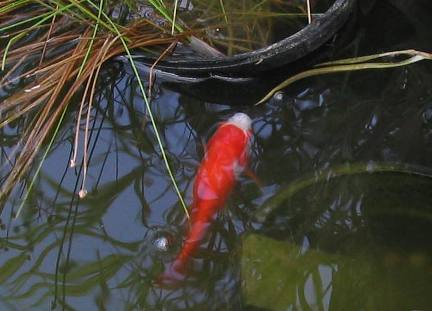
Okay, so maybe the fish in our pond don't qualify as wildlife - we introduced them, and perhaps that makes them "pets". But the current set is several generations removed from the original few, and they live off what the pond provides naturally - so I say they are mostly wild. Visitors to this page have left the following comments
I welcome comments about my web pages; feel free to use the form below to leave feedback about this particular page. For the benefit of other visitors to these pages, I will list any relevant comments you leave, and if appropriate, I will update my page to correct mis-information. Note that I discard any comments including html markups, so please submit your comment as plain text. If you have a comment about the website as a whole, please leave it in my guestbook. If you have a question that needs a personal response, please e-mail me.
Last modified:
September 24, 2022 |
|||||||||||||||||||||||||||||||||||||||||||||||||||||||||||||||||||||||||||
